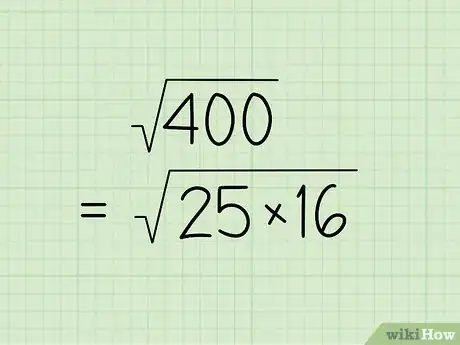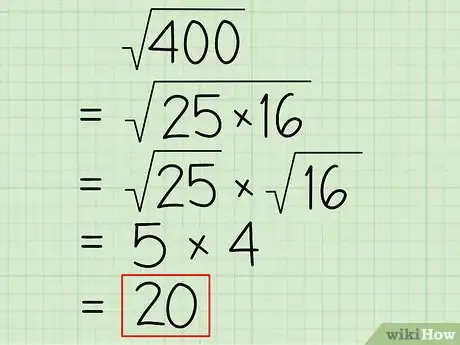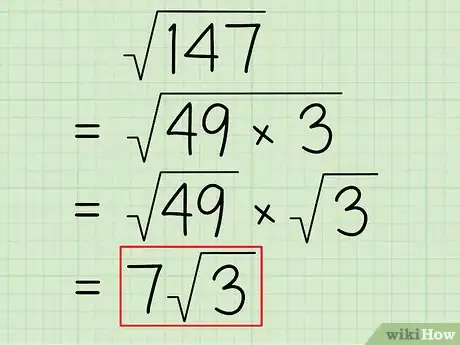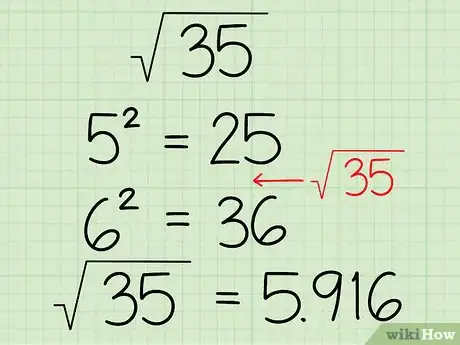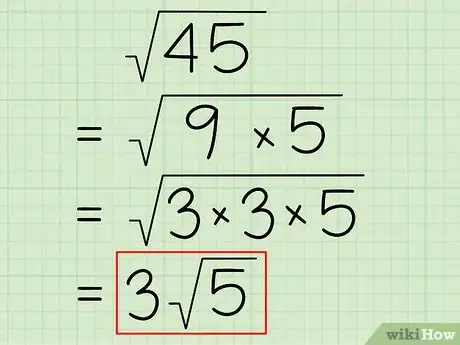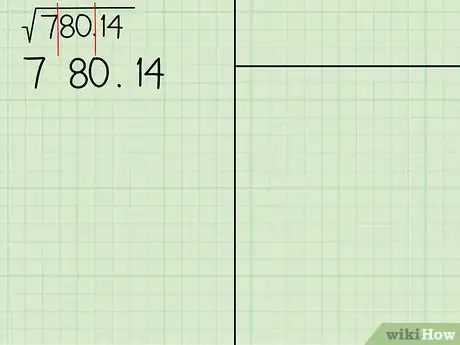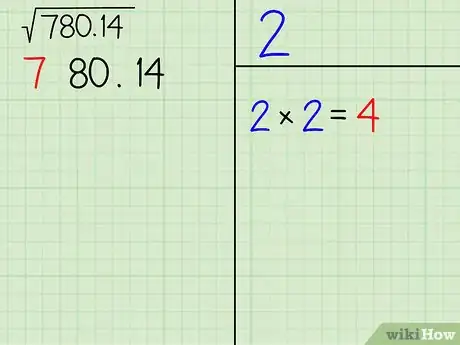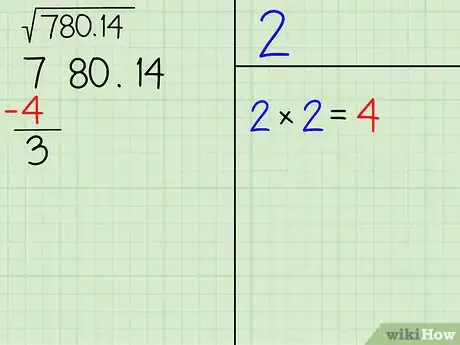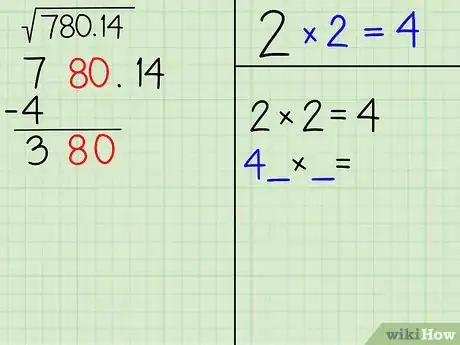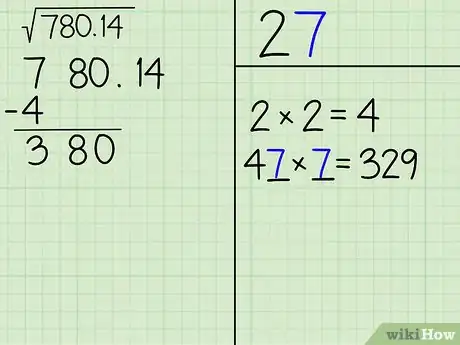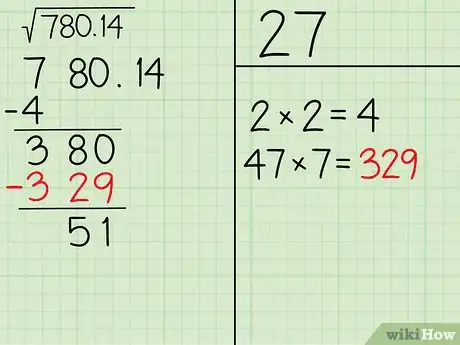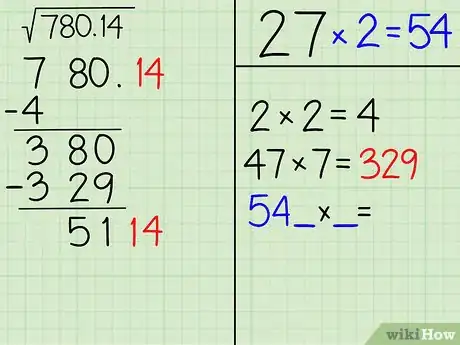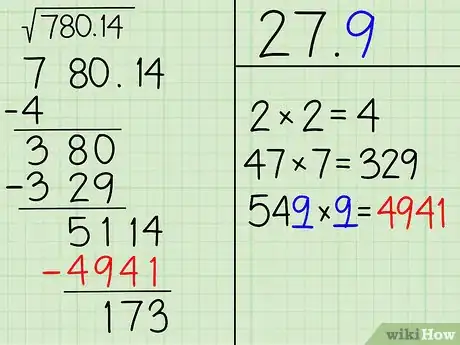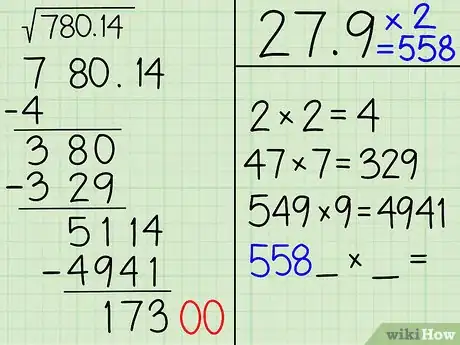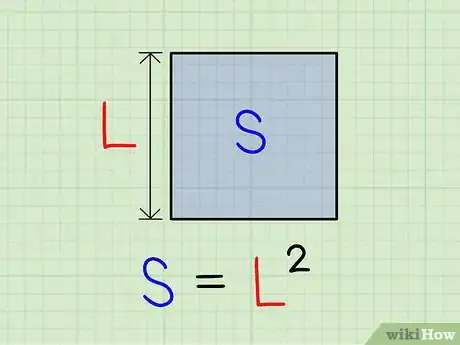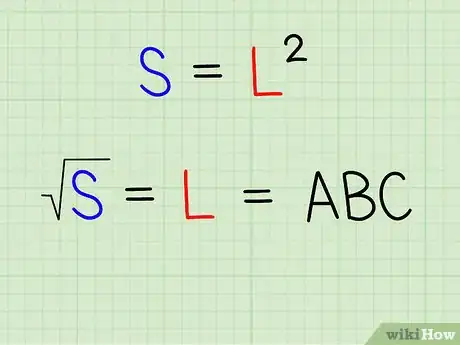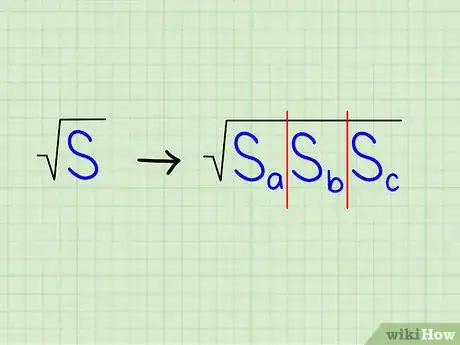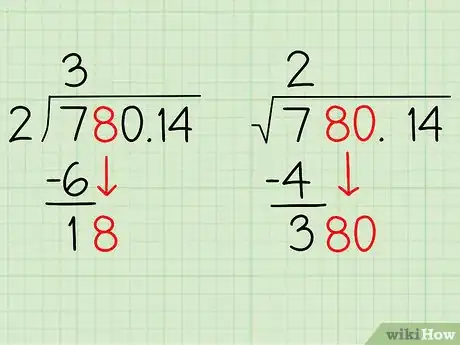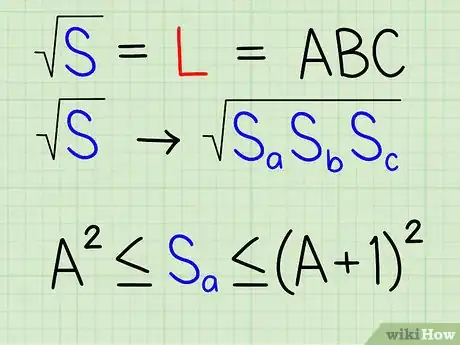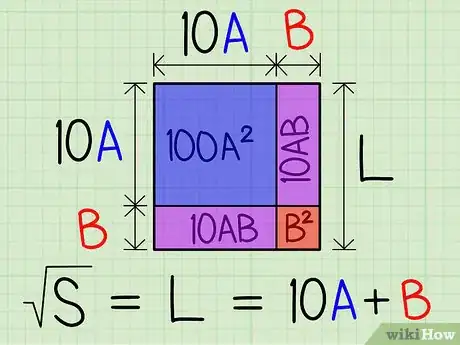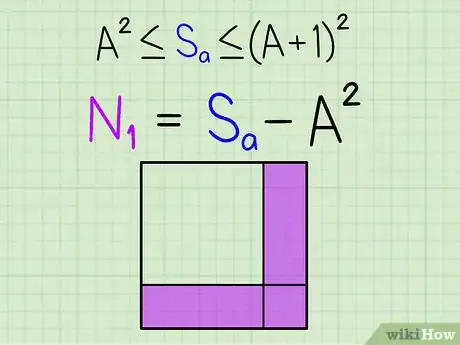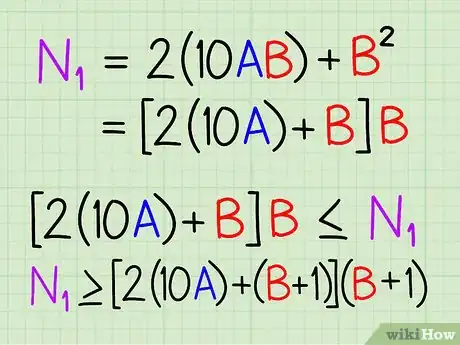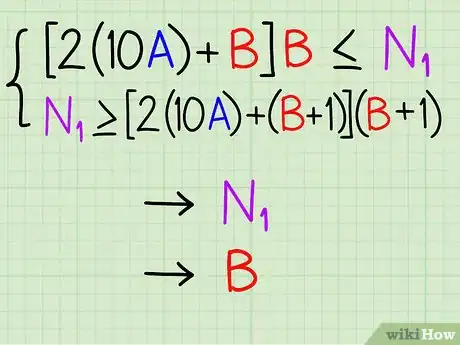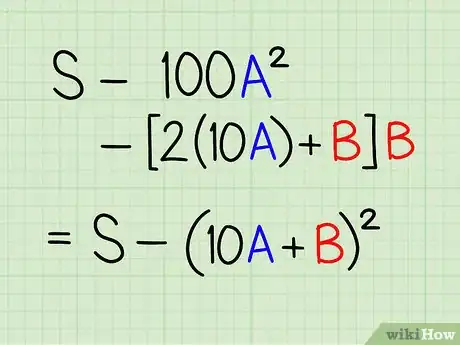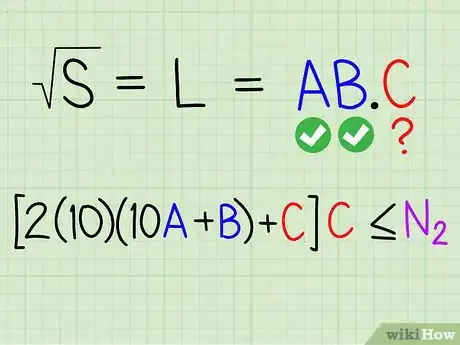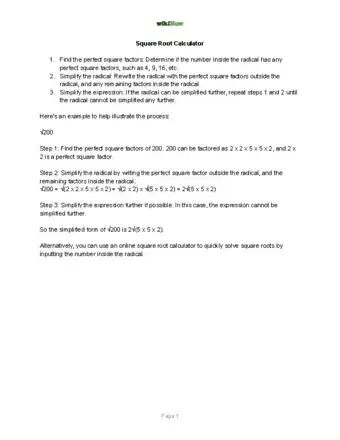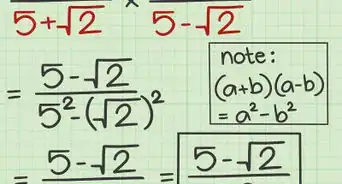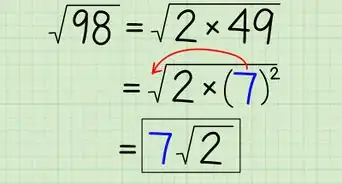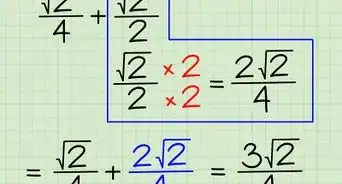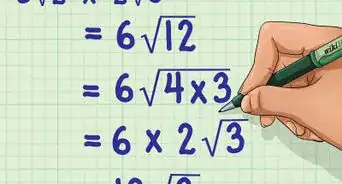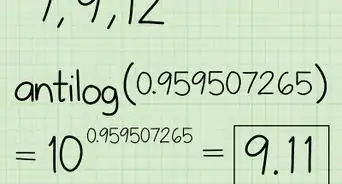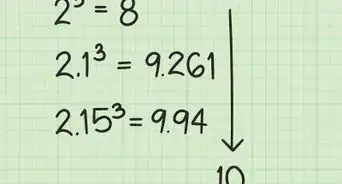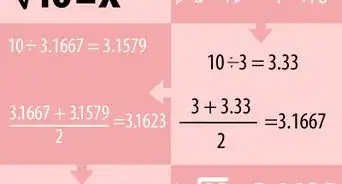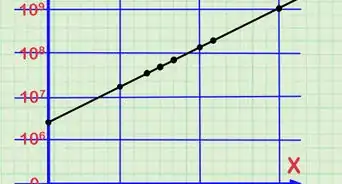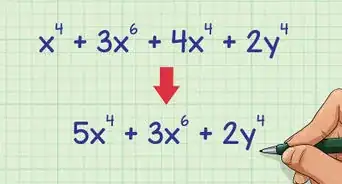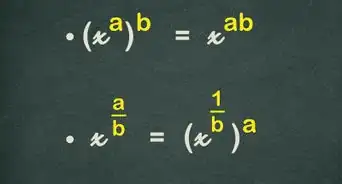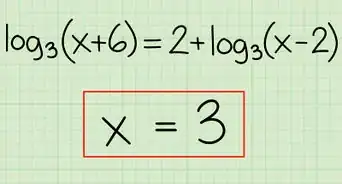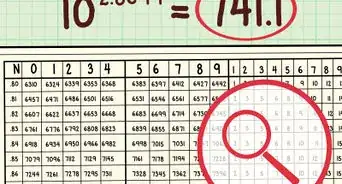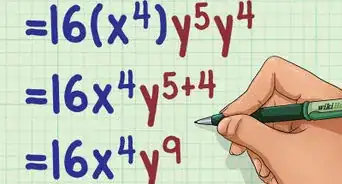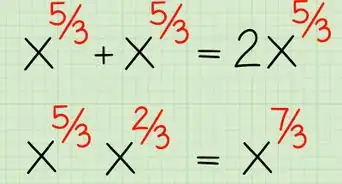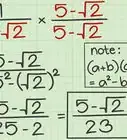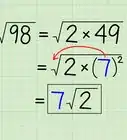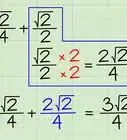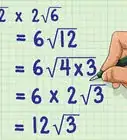This article was co-authored by David Jia. David Jia is an Academic Tutor and the Founder of LA Math Tutoring, a private tutoring company based in Los Angeles, California. With over 10 years of teaching experience, David works with students of all ages and grades in various subjects, as well as college admissions counseling and test preparation for the SAT, ACT, ISEE, and more. After attaining a perfect 800 math score and a 690 English score on the SAT, David was awarded the Dickinson Scholarship from the University of Miami, where he graduated with a Bachelor’s degree in Business Administration. Additionally, David has worked as an instructor for online videos for textbook companies such as Larson Texts, Big Ideas Learning, and Big Ideas Math.
This article has been viewed 2,514,476 times.
In the days before calculators, students and professors alike had to calculate square roots by hand. Several different methods have evolved for tackling this daunting process, some giving a rough approximation, others giving an exact value. To learn how to find a number's square root using only simple operations, please see Step 1 below to get started.
Steps
Using Prime Factorization
-
1Divide your number into perfect square factors. This method uses a number's factors to find a number's square root (depending on the number, this can be an exact numerical answer or a close estimate). A number's factors are any set of other numbers that multiply together to make it.[1] For instance, you could say that the factors of 8 are 2 and 4 because 2 × 4 = 8. Perfect squares, on the other hand, are whole numbers that are the product of other whole numbers. For instance, 25, 36, and 49 are perfect squares because they are 52, 62, and 72, respectively. Perfect square factors are, as you may have guessed, factors that are also perfect squares. To start finding a square root via prime factorization, first, try to reduce your number into its perfect square factors.[2]
- Let's use an example. We want to find the square root of 400 by hand. To begin, we divide the number into perfect square factors. Since 400 is a multiple of 100, we know that it's evenly divisible by 25 - a perfect square. Quick mental division lets us know that 25 goes into 400 16 times. 16, coincidentally, is also a perfect square. Thus, the perfect square factors of 400 are 25 and 16 because 25 × 16 = 400.
- We would write this as: Sqrt(400) = Sqrt(25 × 16)
- You can also try multiplying different numbers by themselves and see if they give you the correct answer. Let's say you were trying to find the square root of 81—you could multiply 7 by 7 to get 49, which is too low. You could go a little higher and multiply 10 by 10 to get 100, which is too high. You could then go a little lower and multiply 9 by 9. This would give you 81, making 9 your square root.
-
2Take the square roots of your perfect square factors. The product property of square roots states that for any given numbers a and b, Sqrt(a × b) = Sqrt(a) × Sqrt(b). Because of this property, we can now take the square roots of our perfect square factors and multiply them together to get our answer.[3]
- In our example, we would take the square roots of 25 and 16. See below:
- Sqrt(25 × 16)
- Sqrt(25) × Sqrt(16)
- 5 × 4 = 20
Advertisement - In our example, we would take the square roots of 25 and 16. See below:
-
3Reduce your answer to simplest terms, if your number doesn't factor perfectly. In real life, more often than not, the numbers you'll need to find square roots for won't be nice round numbers with obvious perfect square factors like 400. In these cases, it may not be possible to find the exact answer as an integer. Instead, by finding any perfect square factors that you can, you can find the answer in terms of a smaller, simpler, easier-to-manage square root. To do this, reduce your number to a combination of perfect square factors and non-perfect square factors, then simplify.[4]
- Let's use the square root of 147 as an example. 147 isn't the product of two perfect squares, so we can't get an exact integer value as above. However, it is the product of one perfect square and another number - 49 and 3. We can use this information to write our answer in simplest terms as follows:
- Sqrt(147)
- = Sqrt(49 × 3)
- = Sqrt(49) × Sqrt(3)
- = 7 × Sqrt(3)
- Let's use the square root of 147 as an example. 147 isn't the product of two perfect squares, so we can't get an exact integer value as above. However, it is the product of one perfect square and another number - 49 and 3. We can use this information to write our answer in simplest terms as follows:
-
4Estimate, if necessary. With your square root in simplest terms, it's usually fairly easy to get a rough estimate of a numerical answer by guessing the value of any remaining square roots and multiplying through. One way to guide your estimates is to find the perfect squares on either side of the number in your square root. You'll know that the decimal value of the number in your square root is somewhere between these two numbers, so you'll be able to guess in between them.
- Let's return to our example. Since 22 = 4 and 12 = 1, we know that Sqrt(3) is between 1 and 2 - probably closer to 2 than to 1. We'll estimate 1.7. 7 × 1.7 = 11.9 If we check our work in a calculator, we can see that we're fairly close to the actual answer of 12.13.
- This works for larger numbers as well. For example, Sqrt(35) can be estimated to be between 5 and 6 (probably very close to 6). 52 = 25 and 62 = 36. 35 is between 25 and 36, so its square root must be between 5 and 6. Since 35 is just one away from 36, we can say with confidence that its square root is just lower than 6. Checking with a calculator gives us an answer of about 5.92 - we were right.
- Let's return to our example. Since 22 = 4 and 12 = 1, we know that Sqrt(3) is between 1 and 2 - probably closer to 2 than to 1. We'll estimate 1.7. 7 × 1.7 = 11.9 If we check our work in a calculator, we can see that we're fairly close to the actual answer of 12.13.
-
5Reduce your number to its lowest common factors as a first step. Finding perfect square factors isn't necessary if you can easily determine a number's prime factors (factors that are also prime numbers). Write your number out in terms of its lowest common factors. Then, look for matching pairs of prime numbers among your factors. When you find two prime factors that match, remove both these numbers from the square root and place one of these numbers outside the square root.
- As an example, let's find the square root of 45 using this method. We know that 45 = 9 × 5 and we know that 9 = 3 × 3. Thus, we can write our square root in terms of its factors like this: Sqrt(3 × 3 × 5). Simply remove the 3's and put one 3 outside the square root to get your square root in simplest terms: (3)Sqrt(5). From here, it's simple to estimate.
- As one final example problem, let's try to find the square root of 88:
- Sqrt(88)
- = Sqrt(2 × 44)
- = Sqrt(2 × 4 × 11)
- = Sqrt(2 × 2 × 2 × 11). We have several 2's in our square root. Since 2 is a prime number, we can remove a pair and put one outside the square root.
- = Our square root in simplest terms is (2) Sqrt(2 × 11) or (2) Sqrt(2) Sqrt(11). From here, we can estimate Sqrt(2) and Sqrt(11) and find an approximate answer if we wish.
Finding Square Roots Manually
Using a Long Division Algorithm
-
1Separate your number's digits into pairs. This method uses a process similar to long division to find an exact square root digit-by-digit. Though it's not essential, you may find that it's easiest to perform this process if you visually organize your workspace and your number into workable chunks. First, draw a vertical line separating your work area into two sections, then draw a shorter horizontal line near the top of the right section to divide the right section into a small upper section and a larger lower section. Next, separate your number's digits into pairs, starting from the decimal point. For instance, following this rule, 79,520,789,182.47897 becomes "7 95 20 78 91 82. 47 89 70". Write your number at the top of the left space.
- As an example, let's try calculating the square root of 780.14. Draw two lines to divide your workspace as above and write "7 80. 14" at the top of the left space. It's O.K. that the leftmost chunk is a lone number, rather than a pair of numbers. You will write your answer (the square root of 780.14.) in the top right space.
-
2Find the largest integer n whose square is lesser than or equal to the leftmost number (or pair). Start with the leftmost "chunk" of your number, whether this is a pair or a single number. Find the largest perfect square that's less than or equal to this chunk, then take the square root of this perfect square. This number is n. Write n in the top right space and write the square of n in the bottom right quadrant.
- In our example, the leftmost "chunk" is the number 7. Since we know that 22 = 4 ≤ 7 < 32 = 9, we can say that n = 2 because it's the largest integer whose square is less than or equal to 7. Write 2 in the top right quadrant. This is the first digit of our answer. Write 4 (the square of 2) in the bottom right quadrant. This number will be important in the next step.
-
3Subtract the number you just calculated from the leftmost pair. As with long division, the next step is to subtract the square we just found from the chunk we just analyzed. Write this number underneath the first chunk and subtract, writing your answer underneath.
- In our example, we would write 4 below 7, then subtract. This gives us an answer of 3.
-
4Drop down the next pair. Move the next "chunk" in the number whose square root you're solving for down next to the subtracted value you just found. Next multiply the number in the top right quadrant by two and write it in the bottom right quadrant. Next to the number you just wrote down, set aside space for a multiplication problem you'll do in the next step by writing '"_×_="'.
- In our example, the next pair in our number is "80". Write "80" next to the 3 in the left quadrant. Next, multiply the number in the top right by two. This number is 2, so 2 × 2 = 4. Write "'4"' in the bottom right quadrant, followed by _×_=.
-
5Fill in the blank spaces in the right quadrant. You must fill each blank space you've just written in the right quadrant with the same integer. This integer must be the largest integer that allows the result of the multiplication problem in the right quadrant to be lower than or equal to the current number on the left.
- In our example, filling in the blank spaces with 8, gives us 4(8) × 8 = 48 × 8 = 384. This is greater than 380. Therefore, 8 is too big, but 7 will probably work. Write 7 in the blank spaces and solve: 4(7) × 7 = 329. 7 checks out because 329 is less than 380. Write 7 in the top right quadrant. This is the second digit in the square root of 780.14.
-
6Subtract the number you just calculated from the current number on the left. Continue with the long-division style chain of subtraction. Take the result of the multiplication problem in the right quadrant and subtract it from the current number on the left, writing your answer below.
- In our example, we would subtract 329 from 380, which gives us 51.
-
7Repeat step 4. Drop the next chunk of the number you're finding the square root of down. When you reach the decimal point in your number, write a decimal point in your answer in the top right quadrant. Then, multiply the number in the top right by 2 and write it next to the blank multiplication problem ("_ × _") as above.
- In our example, since we are now encountering the decimal point in 780.14, write a decimal point after our current answer the top right. Next, drop the next pair (14) down in the left quadrant. Two times the number on the top right (27) is 54, so write "54 _×_=" in the bottom right quadrant.
-
8Repeat step 5 and 6. Find the biggest digit to fill in the blanks on the right that gives an answer lesser than or equal to the current number on the left. Then, solve the problem.
- In our example, 549 × 9 = 4941, which is lower than or equal to the number on the left (5114). 549 × 10 = 5490, which is too high, so 9 is our answer. Write 9 as the next digit in the top right quadrant and subtract the result of the multiplication from the number on the left: 5114 minus 4941 is 173.
-
9Continue to calculate digits. Drop a pair of zeros on the left, and repeat steps 4, 5 and 6. For added accuracy, continue repeating this process to find the hundredth, thousandth, etc. places in your answer. Proceed through this cycle until you find your answer to the desired decimal place.
Understanding the Process
-
1Consider the number you are calculating the square root of as the area S of a square. Because a square's area is L2 where L is the length of one of its sides, therefore, by trying to find the square root of your number, you are trying to calculate the length L of the side of that square.
-
2Specify letter variables for each digit of your answer. Assign the variable A as the first digit of L (the square root we are trying to calculate). B will be its second digit, C its third, and so on.
-
3Specify letter variables for each "chunk" of your starting number. Assign the variable Sato the first pair of digits in S (your starting value), Sb the second pair of digits, etc.
-
4Understand this method's connection to long division. This method of finding a square root is essentially a long division problem that divides your starting number by its square root, thus giving its square root as an answer. Just like in a long division problem, in which you are only interested by the next one digit at a time, here, you are interested by the next two digits at a time (which correspond to the next digit at a time for the square root).
-
5Find the biggest number whose square is less than or equal to Sa. The first digit A in our answer is then the biggest integer where the square does not exceed Sa (meaning A so that A² ≤ Sa < (A+1)²). In our example, Sa = 7, and 2² ≤ 7 < 3², so A = 2.
- Note that, for instance, if you wanted to divide 88962 by 7 via long division, the first step would be similar: you would be looking at the first digit of 88962 (8) and you would want the biggest digit that, when multiplied by 7, is lower than or equal to 8. Essentially, you're finding d so that 7×d ≤ 8 < 7×(d+1). In this case, d would be equal to 1.
-
6Visualize the square whose area you are beginning to solve. Your answer, the square root of your starting number, is L, which describes the length of a square with area S (your starting number). Your values for A,B,C, represent the digits in the value L. Another way of saying this is that, for a two-digit answer, 10A + B = L, while for a three-digit answer, 100A +10B + C = L, and so on.
- In our example, (10A+B)² = L2 = S = 100A² + 2×10A×B + B². Remember that 10A+B represents our answer L with B in the units position and A in the tens position. For instance, with A=1 and B=2, 10A+B is simply the number 12. (10A+B)² is the area of the whole square, while 100A² the area of the biggest square inside, B² is the area of the smallest square, and 10A×B is the area of each of the two remaining rectangles. By performing this long, convoluted process, we find the area of the entire square by adding up the areas of the squares and rectangles inside it.
-
7Subtract A² from Sa. Drop one pair (Sb) of digits from S. Sa Sb is nearly the total area of the square, which you just subtracted the area of the bigger internal square from. The remainder is can be though of as the number N1, which we obtained in step 4 (N1 =380 in our example). N1 is equal to 2×10A×B + B² (area of the two rectangles plus area of the small square).
-
8Look for N1 = 2×10A×B + B², also written as N1 = (2×10A + B) × B. In our example, you already know N1 (380) and A (2), so you need to find B. B is most likely not going to be an integer, so you must actually find the biggest integer B so that (2×10A + B) × B ≤ N1. So, you have: N1 < (2×10A + (B+1)) × (B+1).)
-
9Solve. To solve this equation, multiply A by 2, shift it in the position of the tens (which is equivalent to multiplying by 10), place B in the position of the units, and multiply the resulting number by B. In other words, solve (2×10A + B) × B. This is exactly what you do when you write "N_×_=" (with N=2×A) in the bottom right quadrant in step 4. In step 5, you find the biggest integer B that fits on the underscore so that (2×10A + B) × B ≤ N1.
-
10Subtract the area (2×10A + B) × B from the total area. This gives you the area S-(10A+B)² not yet accounted for (and which will be used to calculate the next digits in a similar fashion).
-
11To calculate the next digit C, repeat the process. Drop the next pair (Sc) from S to obtain N2 on the left, and look for the biggest C so you have (2×10×(10A+B)+C) × C ≤ N2 (equivalent to writing two times the two-digit number "A B" followed by "_×_=" . Look for the biggest digit that fits in the blanks that gives an answer that is less than or equal to N2, as before.
Community Q&A
-
QuestionIs 28 a perfect number?
 DonaganTop AnswererYes. A "perfect" number is a positive integer which is the sum of all of its positive divisors (except itself). Thus, 28 = 1 + 2 + 4 + 7 + 14.
DonaganTop AnswererYes. A "perfect" number is a positive integer which is the sum of all of its positive divisors (except itself). Thus, 28 = 1 + 2 + 4 + 7 + 14. -
QuestionWhat is the square root of 0.000121?
 Community Answer.011. If you are calculating it by hand, here's what to do: 121's sqrt is 11. To get .000121, you simply find an amount of 0's after the decimal point and the number 11 afterwards. Then multiply by itself. .011*.011= .000121.
Community Answer.011. If you are calculating it by hand, here's what to do: 121's sqrt is 11. To get .000121, you simply find an amount of 0's after the decimal point and the number 11 afterwards. Then multiply by itself. .011*.011= .000121. -
QuestionCan I write the cube root of x as (1/x)^1/3?
 DonaganTop AnswererNo, it's (x)^1/3.
DonaganTop AnswererNo, it's (x)^1/3.
Warnings
- Be sure to separate the digits into pairs from the decimal point. Separating 79,520,789,182.47897 as "79 52 07 89 18 2.4 78 97" will yield a useless number.⧼thumbs_response⧽
Calculator
References
- ↑ http://www.mathsisfun.com/definitions/factor.html
- ↑ https://www.math-only-math.com/square-root-of-a-perfect-square-by-using-the-prime-factorization-method.html
- ↑ https://www.math-only-math.com/square-root-of-a-perfect-square-by-using-the-prime-factorization-method.html
- ↑ https://www.math-only-math.com/square-root-of-a-perfect-square-by-using-the-prime-factorization-method.html
About This Article
To calculate a square root by hand, first estimate the answer by finding the 2 perfect square roots that the number is between. A perfect square root is any square root that's a whole number. For example, if you're trying to find the square root of 7, first you'd need to find the first perfect square below 7, which is 4, and the first perfect square above 7, which is 9. Then, find the square root of each perfect square. The square root of 4 is 2, and the square root of 9 is 3. Therefore, you know that the square root of 7 falls somewhere between 2 and 3. Now, divide your number by one of the perfect square roots you found. For example, you would divide 7 by either 2 or 3. If you were to choose 3, your answer would be 2.33. Next, find the average of that number and the perfect square root. To find the average in this example, add 2.33 and 2, then divide by 2 and get 2.16. Repeat the process using the average you got. First, divide the number you're trying to find the square root of by the average. Then, find the average of that number and the original average by adding them together and dividing by 2. For example, first you would divide 7, the number you started with, by 2.16, the average you calculated, and get 3.24. Then, you'd add 3.24 to 2.16, the old average, and divide by 2 to find the new average, which is 2.7. Now, multiply your answer by itself to see how close it is to the square root of the number you started with. In this example, 2.7 multiplied by itself is equal to 7.29, which is 0.29 away from 7. To get closer to 7, you would just repeat the process. Keep dividing the number you started with by the average of that number and the perfect square, using that number and the old average to find the new average, and multiplying the new average by itself until it equals your starting number. If you want to learn how to use the long division algorithm to find the square root, keep reading the article!
